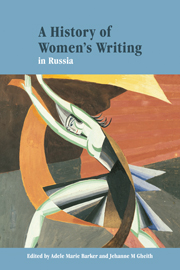Book contents
- Frontmatter
- Contents
- Notes on contributors
- Acknowledgments
- Note on transliteration
- List of abbreviations
- Introduction
- 1 Women's image in Russian medieval literature
- 2 Sappho, Corinna, and Niobe: genres and personae in Russian women's writing, 1760–1820
- 3 The inexperienced muse: Russian women and poetry in the first half of the nineteenth century
- 4 Women of the 1830s and 1850s: alternative periodizations
- 5 “A particle of our soul”: prerevolutionary autobiography by Russian women writers
- 6 The women of Russian Montparnasse (Paris, 1920–1940)
- 7 Women in Russian Symbolism: beyond the algebra of love
- 8 The eastern path of exile: Russian women's writing in China
- 9 Realist prose writers, 1881–1929
- 10 Women and gender in post-symbolist poetry and the Stalin era
- 11 Writing the female body politic (1945–1985)
- 12 In their own words? Soviet women writers and the search for self
- 13 Women's poetry since the sixties
- 14 The persistence of memory: women's prose since the sixties
- 15 Perestroika and post-soviet prose: from dazzle to dispersal
- Bibliographical guide to writers and their works
- Guide to further reading
- Index
6 - The women of Russian Montparnasse (Paris, 1920–1940)
Published online by Cambridge University Press: 22 September 2009
- Frontmatter
- Contents
- Notes on contributors
- Acknowledgments
- Note on transliteration
- List of abbreviations
- Introduction
- 1 Women's image in Russian medieval literature
- 2 Sappho, Corinna, and Niobe: genres and personae in Russian women's writing, 1760–1820
- 3 The inexperienced muse: Russian women and poetry in the first half of the nineteenth century
- 4 Women of the 1830s and 1850s: alternative periodizations
- 5 “A particle of our soul”: prerevolutionary autobiography by Russian women writers
- 6 The women of Russian Montparnasse (Paris, 1920–1940)
- 7 Women in Russian Symbolism: beyond the algebra of love
- 8 The eastern path of exile: Russian women's writing in China
- 9 Realist prose writers, 1881–1929
- 10 Women and gender in post-symbolist poetry and the Stalin era
- 11 Writing the female body politic (1945–1985)
- 12 In their own words? Soviet women writers and the search for self
- 13 Women's poetry since the sixties
- 14 The persistence of memory: women's prose since the sixties
- 15 Perestroika and post-soviet prose: from dazzle to dispersal
- Bibliographical guide to writers and their works
- Guide to further reading
- Index
Summary
The Russians who left their homeland during the years just after the Bolshevik Revolution remained a “society abroad,” to use Marc Raeff's phrase. Deprived of their citizenship by Soviet decree in 1921, many of those who emigrated to Europe did not receive foreign passports until after World War II, when others, inspired by war-era patriotism, finally applied for Soviet citizenship. (A small number repatriated earlier.) This generation of post-revolutionary émigrés, known as the First Wave, made little effort at assimilation within their host countries, choosing instead to recreate Russia in microcosm. They established their own cultural institutions–newspapers, theaters, publishing houses–and sustained a vital intellectual scene. In Berlin and Prague, the early centers of the emigration, this process was linked to cultural developments in the “metropolis,” as Soviet Moscow was called. It was only in Paris, which became the acknowledged capital of émigré Russia in the mid-1920s and remained so until the war, that a distinct émigré culture evolved.
The situation of Russian émigré writers in Paris is thrown into relief by their literal proximity to a second foreign literary community, that of expatriate American writers. Both the Russians and the Americans wrote primarily in their native tongue, though they had personal and creative ties with the French intelligentsia. The expatriate conclave featured a number of women, such as Natalie Barney, Gertrude Stein, H. D. (Hilda Doolittle), Kay Boyle, and Djuna Barnes.
- Type
- Chapter
- Information
- A History of Women's Writing in Russia , pp. 117 - 133Publisher: Cambridge University PressPrint publication year: 2002
- 1
- Cited by



